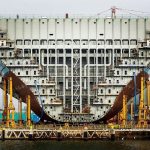Military ship design is an area of continuous implementation and research. The reason for the demand in the implementation and improvement of military ships is becoming more and more evident with war and national security being on the core national agenda of various governments worldwide.

With the advent of war becoming more of a daily reality in many countries around the world, the need for design and improvement in military ships design is becoming more evident. The team comprising of what and how an eventual military ship prototype should look like and function consists of naval planners, designers, design analysts and development and research engineers.
The interaction of these key personnel involves the naval planner identifying and consolidating a need for the ship design in the form of a design brief; designers then taking the design brief to develop an effectively detailed instruction for manufacture; design analysts assisting the designers in assessing the core necessity and relevance of the design proposals; development engineers carrying out feasibility tests and adjustments to the design; and research engineers who finalize any potential gaps in the understanding of materials, processes, and techniques by carrying out experimental and theoretical work.
Aspects of Military Ship Design

The design of the ship consists of both an external aspect and an aspect that deals with internal components. Both internal and external aspects need to be specifically suited to the ship’s core functionality. Externally, in terms of topside arrangement, focus should be placed on the following items:
· Antenna location – The location of the antenna is of crucial importance considering its functional responsibility. Radiated power and reception are among the most important of these. The structure, layout, and design of the antenna arrangements are crucial factors in determining the amount of reception and radiated power generated.The antenna arrangement usually consists of various receiver and transmitter antennas. Onboard space to accomodate these antennas is commonly achieved through certain external design compromises.
· Combat system equipment – Equipment for a ship’s combat system needs to be fully functional, updated, and operated by a skilled, educated, and trained professional. The combat system of a ship enables the control staff to effectively communicate adminstrative and operational data to all on board. Timely and accurate tactical pictures can be created using this equipment. Some elements of this equipment include radars, combat data systems, identification sensors as well as all information displays and their associated equipment.
- Weapon firing arc arrangements – The arrangement of a ship’s firing equipment needs to be placed in such a way that the normal operational requirements can continue unhindered and the discharged ammunition has a clear path towards the intended target. All mounted firing weapons arrangement needs to be accomodating to the type of warfare expected. For instance, it would make hardly any sense if a military ship was restricted in its target range for air-borne attack and could only fire in a flat, horizontal manner when being attacked by F-16 fighter jets.
- Auxiliary and main machinery space – It is through the inertia, force and energy of these key components where the thrust and forward motion of the ship is derived. In most cases, propulsion machinery is located at the furthest back end of the ship. If anything, the most fundamental element of ship design is incorporating space and installation objectives to accomplish required speed and power output.
- Command and control compartments – These compartments are crucial in effectively relaying and receiving information to and from given recipients. Compartments suited for the purpose of commmand control were found in amphibious command ships specifically suited to provide command control to fleet commanders.
- Weapons compartments – These are the compartments within the ship where firing equipment can be found. Weapons compartments are the means by which the firing ability and capacity of the ship is projected to its intended target.
- Flight deck and hanger layout arrangements – Many miltary ships have the capability of launching and retrieving fighter jets. The obvious advantage of this is that a fighter jet can be used for reconnaissance and transported a lot closer to its intended target area as opposed to it flying the entire way. Fighter jets are also a lot more agile in avoiding satellite detection than ships.
Internal engineering deals with components including the following:
- Compartment arrangement
- System specification
- Comprehensive engineering analysis.
Need for Extensive Checks
Extensive and rigorous checks are performed before the ship is accepted into the service of the navy. The reason for this type of checking is beacuse a minuscule deviation of a single system from the initial specification of the intended ship in its entirety may lead to an exponential malfunction of other systems.
Extreme emphasis is also placed in advancements in technology when designing a military ship. Improved radar, missile and gun-based system technology is at the forefront of continuously changing offensive and defensive military tactics. The ability of a warship to continue in battle after suffering considerable damage is also an important design characteristic. Its ability herein would be measurable by the its post-damage stability, water-tight integrity as well as its ballistic and shock protection mechanisms.
The challenge in future military ship design lies in providing and improving all aspects of the warship platform and dynamic stability, fuel economy, seakeeping, speed and signature management.


